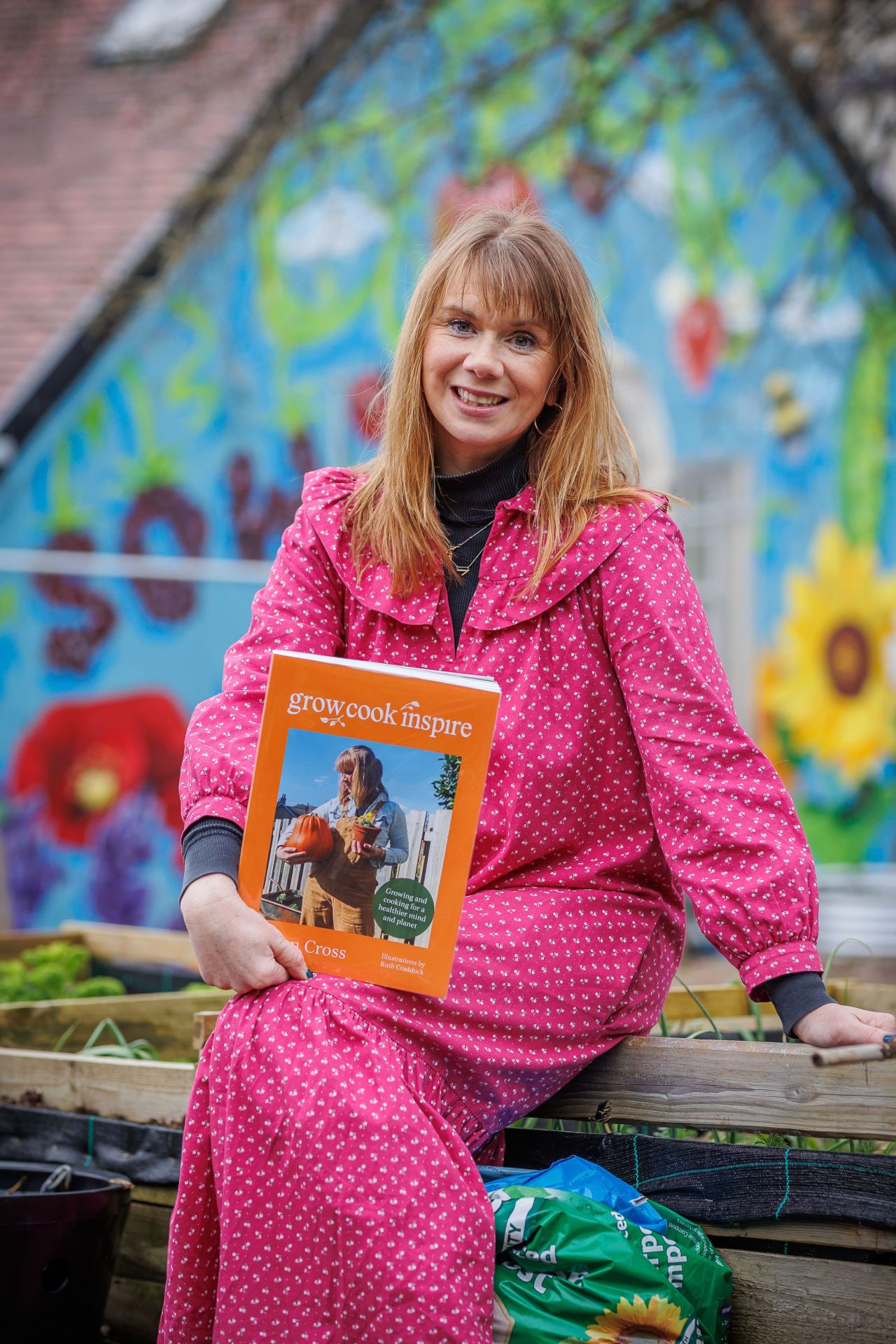In this interview with Helen Cross, the author of ‘Grow, Cook, Inspire’, we learn about her journey from a farm in southwest Scotland to city life in Glasgow. Her strong connection to nature, stemming from her rural upbringing, has influenced her passion for gardening and sustainable living.
Now a communication consultant and author, she shares her experiences and practical tips on gardening, cooking and inspiring others to connect with the outdoors. We explore her story and discover how to bring gardening and sustainability into our daily lives as part of ‘At Home With’ series.

Helen Cross | Photo by Nick Mailer
Can you tell us a little bit more about yourself?
I grew up on a farm in southwest Scotland, where my family still lives. This nurtured a deep appreciation for the outdoors and how food is grown, along with a commitment to protecting nature for future generations. Like many countryside teenagers, I couldn’t wait to leave, so at 17, I left home to study history at university. Now, with three children, I appreciate the beauty and freedom of Wigtownshire.
For over 18 years, I’ve worked in media and public relations, specialising in food, farming and horticulture. While I continue as a communication consultant, I now focus more on writing and presenting. My first book, ‘Grow, Cook, Inspire’, published last year, brings together my love of food and gardening.
We’ve moved frequently due to my husband’s career as a professional rugby player. After living in Edinburgh and London, we now call Glasgow home. Despite living in an urban centre, our beautiful garden inspired my book, which I wrote during the pandemic. It fuels my passion for growing flowers, fruit and vegetables, and entertaining friends and family.
I’m also an RHS Schools Gardening Champion, working with schools to bring the classroom outdoors and encourage children to garden for the planet’s benefit and their wellbeing. For the past few years, I’ve had the privilege of hosting the main stage at the Chelsea Flower Show.
Could you share a memorable experience from your own gardening and cooking journey that inspired a part of your book?
I was very unwell during the pandemic, having long suffered from depression and anxiety, but the garden saved me. With three small children under the age of five at home, while my husband works as a doctor (and previously as a professional rugby player), the garden became a place to escape and channel my energy into creating something positive for myself and my children.
Realising we wouldn’t be returning to the countryside, I wanted to give my children a taste of my childhood. We spent a lot of time in the garden, growing food and creating a wildlife-friendly space. This healthy obsession grew over time. I wanted to share my love of gardening with more people and encourage everyone to give it a go, whether they are 5 or 85. That is how ‘Grow, Cook, Inspire’ evolved.


Gardening can seem overwhelming to beginners. What straightforward advice can help those unsure about starting, and how can they manage common challenges?
There is no right or wrong way to garden. Even the most experienced gardeners make mistakes and a lot is down to trial and error. A garden should be an expression of your personality; it doesn’t have to be carefully curated. Grow what you love, don’t follow trends, and most importantly, in terms of growing food, grow what you love to eat. Although radishes are quick to grow, there’s no point in growing them if you don’t like them! Start small and enjoy the process. It’s a cliché, but gardening should spark joy.
Your book focuses on sustainability, with advice on recycling and cutting down on food waste. What are some simple ways families can work these ideas into their everyday gardening and cooking routines?
Try to compost as much of your kitchen waste as possible – it’s surprisingly satisfying. If you’re tight on space, start with herbs (something like sage, mint or lemongrass), which can be split into four or six new plants. Recycle where possible; if you can drill a hole in it, you can probably grow something in it. I’ve got wellies, cattle troughs, bread bins and watering cans brimming with plants.
Your book, ‘Grow, Cook, Inspire’ is full of gardening and cooking tips for families. Could you share your favourite seasonal recipe from the book that uses fresh produce straight from the garden?
In the summer, I love nothing more than walking into the garden to pick salad leaves, edible flowers and courgettes (if the slugs haven’t beaten me to them). Good food doesn’t have to be complicated; the best meals are made with fresh, seasonal ingredients. There are no food miles, just food steps. These ingredients make a lovely salad on their own or served with salmon, chicken, or, in my house, sausages. But it’s the dressing that really makes it sing.


Garden Fresh Salad with Courgettes and Edible Flowers
This fresh salad brings together crisp leaves, golden courgette slices, and edible flowers, all topped with a honey-lime tahini dressing for a balanced flavour. Serve it with roasted sugar snap peas, dressed with lemon juice and Parmesan. It’s an easy and inviting choice for a light meal or a starter.
Ingredients:
- A few handfuls of fresh salad leaves
- 2 small courgettes, thinly sliced into rounds
- Edible flowers: nasturtium flowers and calendula petals
- Seed mix: lightly toasted pumpkin seeds, sunflower seeds and fennel seeds
Dressing:
- 3 tablespoons olive oil
- 2 cloves garlic, crushed
- Juice of 1 lime
- 3 teaspoons honey
- 3 teaspoons tahini
Side Dish:
- Sugar snap peas
- Olive oil
- Lemon juice
- Parmesan shavings
- Extra nasturtium leaves and flowers for garnish
Method:
This fresh salad brings together crisp leaves, golden courgette slices, and edible flowers, all topped with a honey-lime tahini dressing for a balanced flavour.
Serve it with roasted sugar snap peas, dressed with lemon juice and Parmesan. It’s an easy and inviting choice for a light meal or a starter.
Prepare the Salad:
-
- To assemble the salad, pick a few handfuls of salad leaves.
- Thinly slice the courgettes into rounds. Fry them in a pan with a little oil for 2 minutes on each side, until golden brown.
- Lay the fried courgettes on top of the salad leaves.
- Add a handful of nasturtium flowers and calendula petals to the salad for colour and flavour.
- Sprinkle the seed mix over the top.
Make the Dressing:
-
- In a small bowl, mix the olive oil, crushed garlic, lime juice, honey and tahini until smooth.
- Drizzle the dressing over the salad just before serving.
Prepare the Side Dish:
-
- Toss the sugar snap peas in olive oil and roast in the oven at 200°C for 10 minutes.
- Once roasted, dress with a squeeze of lemon juice and a sprinkle of Parmesan shavings.
- Garnish with nasturtium leaves and flowers making it look picture-perfect.
For more information on Helen Cross’s book, visit growcookinspire.com or follow her on Instagram @Grow_Cook_Inspire
In celebration of National Allotment Week, we’re all about the simple joy of growing your own food and feeling connected with nature. Helen Cross’s journey illustrates the joy of connecting with nature through gardening and cooking.
Inspired by her story, our ‘Edibles & Wildlife’ collection is here to help you create your own edible garden at home. With easy-to-grow plants that support local wildlife, it’s perfect for beginners and experienced gardeners alike.
Discover how you can bring a touch of the outdoors into your daily life. Read more about our ‘Edibles & Wildlife‘ collection on our blog to start your journey.






